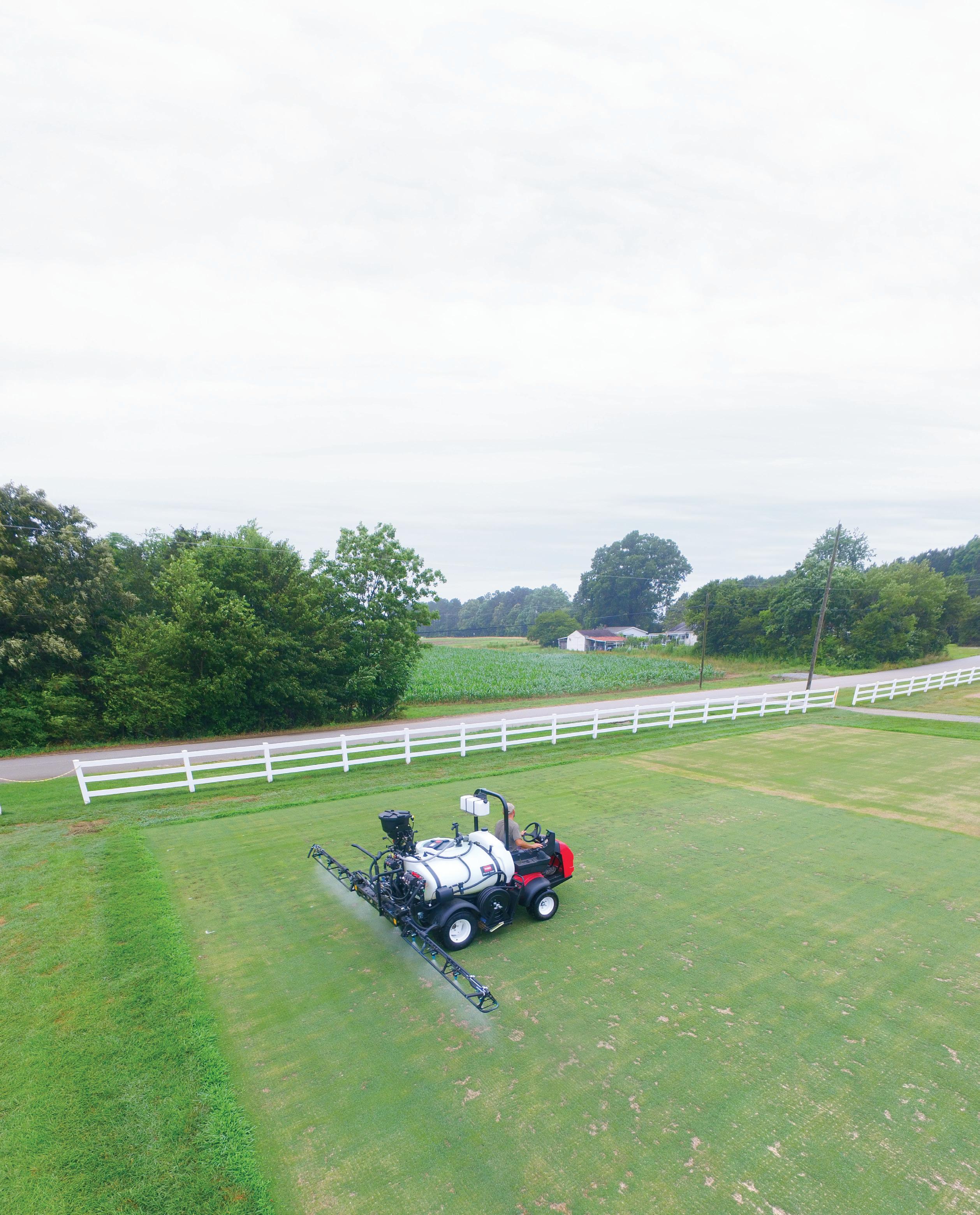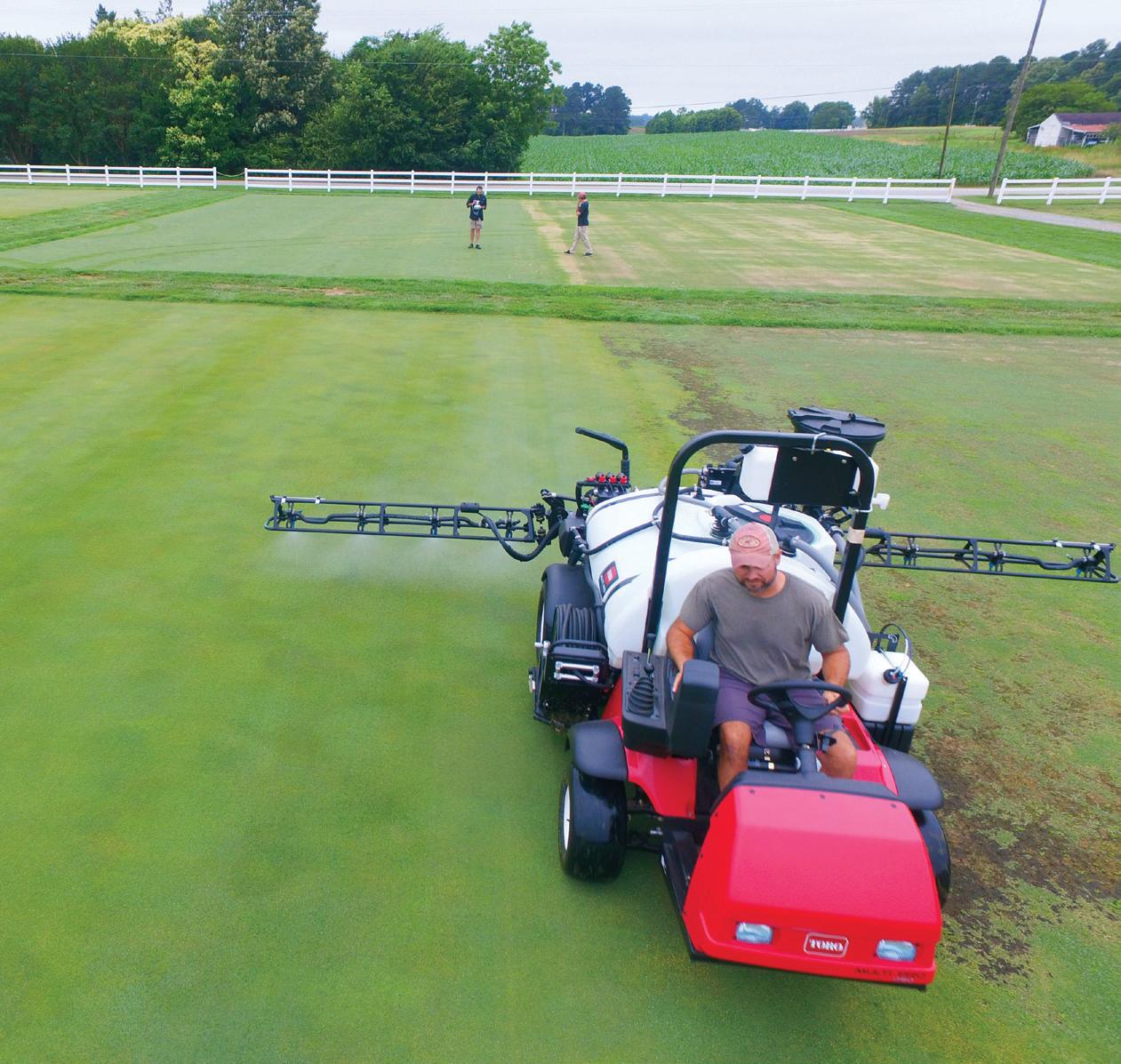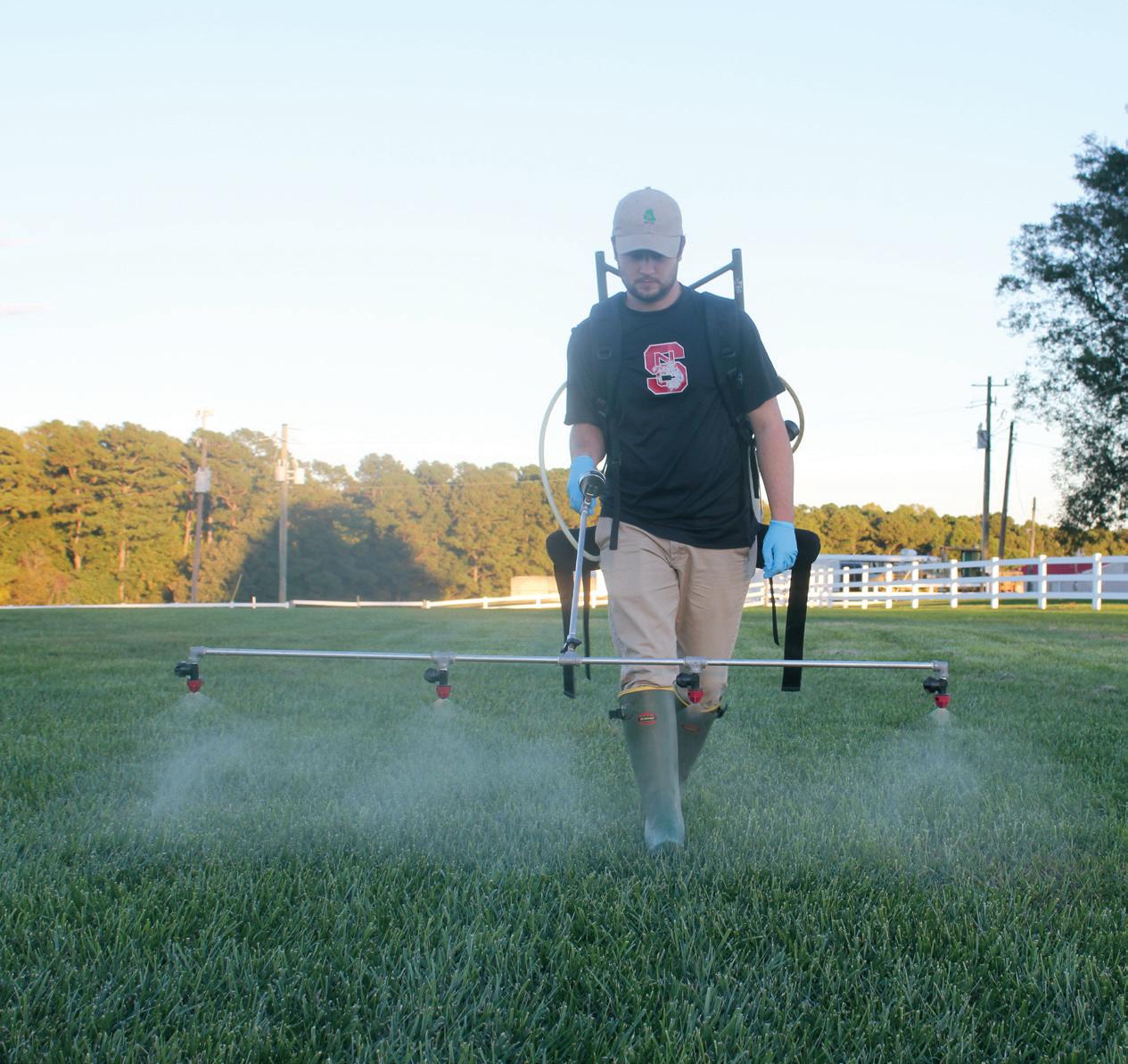
8 minute read
Misconceptions, Understanding Fate, and Optimizing Pesticide Applications in Turfgrass
By Travis W. Gannon, PhD, NC State University • Travis_gannon@ncsu.edu • @TravisWGannon
Misconceptions around pesticides and their use in today’s society
Advertisement
While there is currently much scrutiny around pesticides and their use, synthetic pesticides are an integral component of comprehensive pest management programs in all facets of agriculture including athletic fields, golf courses, lawns, sod production and other turfgrass areas. While this is not a new interest or concern, it is currently heightened, likely for a number of reasons including the International Agency for Research on Cancer classification of glyphosate as a Class 2A probable carcinogen to humans in 2015 and subsequent events. While pesticides are an integral component, they must be used judiciously. It is imperative that facility managers understand various aspects of their utilization so environmental and human health aren’t adversely affected. Let’s start with a partial list of common misconceptions about pesticide use and we’ll address a few in limited detail:
• Pesticides offer little (or no) benefit in today’s society
• Pesticides persist a very long time (some believe forever)
• Pesticides adversely affect human and environmental health, cause various diseases and illnesses
• Pesticides move off-target and contaminate streams, surface water bodies, etc.
• Pesticides aren’t adequately evaluated prior to commercialization and aren’t regulated after commercialization
• Facilities maintained with organic products are safer than those maintained with synthetic pesticides
• Pesticides are to blame for bee colony collapse disorder
Pesticides offer little (or no) benefit in today’s society.
In major agronomic crops, the primary benefit of pesticides is to increase or maximize yield. While yield isn’t of concern in turfgrass systems, pesticides offer various environmental, human, social and economic benefits. Specifically, pesticides are a component of comprehensive pest management programs which enable turfgrass managers to maintain an aesthetically pleasing, functional, and safe playing surface.
Pesticides aren’t adequately evaluated prior to commercialization.
In the US, the Environmental Protection Agency (EPA) is responsible for regulation and oversight at the federal level. The EPA has a very rigorous set of guidelines and laws for evaluation before a pesticide is registered, as well as when it is reregistered. Further, a comprehensive battery of biology, environmental fate, and toxicological studies are required prior to registration. While it’s not within the scope of this article, those interested can refer to the following federal laws to learn more about the agency’s oversight: The Federal Insecticide, Fungicide, and Rodenticide Act, The Federal Food, Drug and Cosmetic Act, The Food Quality Protection Act and The Endangered Species Act of 1973. Further, pesticides must be registered at the state level which may require additional tests for registration. Finally, some local governments, municipalities, etc. may require additional tests or impose additional regulations for registration and/or use.

Photo courtesy of Patrick Maxwell
Pesticides adversely affect human and environmental health.
First and foremost, pesticides should always be used in accordance with label directions and it is a violation of federal law to use a pesticide in a manner inconsistent with its label. One doesn’t have to search hard to find reports of glyphosate in various foods (Cheerios, oatmeal, granola and snack bars, etc.), there have even been reports of detection in beer. Obviously, no one wants to intentionally consume glyphosate (or any other pesticide for that matter) but what are the implications of this? Combining toxicity and exposure is an area many laypeople do not think about or do not understand.
Let’s take the highest amount of glyphosate detected in oats and combine that with California’s very conservative limit for glyphosate, how much would a person have to eat to reach an adverse effect level? Answer: > 12 servings each day.
Similarly, let’s take the highest amount of glyphosate detected in beer and combine that with allowable intake, how many beers would a person have to drink to reach an adverse effect level (from glyphosate)? Answer: > 2,800–12 oz beers in a day.
Pesticides are to blame for bee colony collapse disorder.
While scientists acknowledge pesticides contribute to colony collapse disorder, many other factors play a significant role including: varroa mite, various diseases and parasites, stress due to management practices (transporting hives to various locations to provide pollination services), changes in habitat, and loss of forage/poor nutrition, among others. Further, associated pesticide exposure is due to agricultural applications as well as applications directly to hives.
Understanding pesticide fate after application
Understanding pesticide fate after application is important in all agronomic systems including turfgrass systems. After a pesticide is applied, various processes ensue and its fate depends on many chemical, biological and physical properties. After application, pesticides are subject to various transfer and transformation processes. Fundamentally, transfer processes involve the movement of a pesticide from one compartment to another while transformation processes involve degradation or alteration of the pesticide.
Key transfer processes include:
• Adsorption – binding to soil colloids
• Absorption – uptake by plants and/or microorganisms
• Volatilization – conversion from liquid or solid to gas or vapor
• Runoff – lateral movement across a soil surface
• Leaching – downward distribution within a soil profile
Key transformation processes include:
• Photodecomposition (photolysis) –degradation by sunlight
• Hydrolysis – degradation by water
• Microbial decomposition – degradation by microorganisms (fungi, bacteria, etc.)
• Chemical decomposition – degradation by various chemical reactions in soil
Specifically, in turfgrass systems, if a pesticide is not incorporated and remains on the foliage, major routes include foliar absorption, photolysis, and volatilization, among others. If a pesticide is incorporated (most commonly with irrigation in turfgrass systems), varying amounts move into the turfgrass canopy, thatch layer, or soil where it is subject to root absorption, adsorption to soil colloids or organic matter, leaching, and biological and chemical degradation, among others. Understanding biology of the target pest as well as behavior of the pesticide enables turfgrass managers to optimize pesticide applications resulting in fiscal savings and reduced pesticide inputs.

Photo courtesy of Patrick Maxwell
Optimizing Pesticide Applications
General practices
• Measure accurately
• Calibrate often
• Thoroughly read and follow label directions
• If there’s a question, contact a reputable, trusted resource
• Consider weather conditions
Prior to, at application, as well as after application
• Use split applications when appropriate (ex. preemergence herbicides)
• Be mindful of edaphic properties
Pesticides behave much differently in sand medium versus soil containing clay
Be aware of the amount of organic matter in your system and make necessary adjustments
• Develop comprehensive pest management plans
Pesticide selection
• Select pesticide based on use site, turf species, positive pest identification, etc.
• Understand biology of the pest and schedule application according to maximum susceptibility or efficacy
• Use minimum effective application rates
Pesticide application timing
• Schedule pesticide applications to minimize pesticide exposure.
Dermal contact with treated surfaces is a major route of exposure for nonworkers. A common question that arises from athletes or parents is “how long after a pesticide is it safe for us to use the area”. Recent research from our program at NC State University has investigated factors that affect dislodgeable pesticide residues from treated turf surfaces. While there are many factors that influence this, time between application and activity is the most influential factor. Specifically, for compounds with short persistence, dislodgeability declined as days from application increased with limited or no detection beyond ~10 days. Further, dislodgeability declined as time progressed within a day with limited or no detection during the afternoon hours which is likely due to turfgrass canopy moisture varying throughout the day. Other factors such as turfgrass species, pesticide, time of day, irrigation inputs, and pesticide formulation, among others, also influence the amount of a pesticide that may be transferred from the turfgrass surface to users. In conclusion, pesticides may dislodge from treated surfaces after application; however, through appropriate management practices and scheduling, dermal exposure can be managed below adverse thresholds.

Photo courtesy of Daniel Freund
• Schedule pesticide applications accordingly with cultural practices to maximize efficacy.
It is important for turfgrass managers to schedule pesticide applications appropriately with other cultural and management practices to maximize efficacy. Many cultural and management practices including mowing and irrigation inputs can influence pesticide fate and behavior and have been the focus of much research recently. Specifically, a single mowing event one day after a pesticide application can remove up to 35% of the applied pesticide from a managed bermudagrass, zoysiagrass or tall fescue system which has significant implications on efficacy. Further, if clippings are returned to the turfgrass canopy, most pesticides will not be bioavailable as they must be released from the clippings, at which point most will be sorbed to soil or organic matter. In conclusion, to maximize foliar absorption and efficacy, mowing should be delayed after pesticide applications.
If targeting soil-borne pests, application carrier volume, irrigation timing and amount and other tools such as wetting agents may aid in moving the pesticide to the target. This is also an area of ongoing research but preliminary data suggest irrigating immediately after application enhances pesticide distribution in the soil profile compared to delaying irrigation for as few as 4 hours. Increasing carrier volume and irrigation amount as well as the inclusion of a wetting agent can also aid in pesticide placement when targeting soil-borne pests.
Conclusions
As previously stated, all pesticides registered in the US are subject to a rigorous battery of tests which combine toxicity and exposure to ensure risks don’t outweigh benefits (i.e. they don’t adversely affect human or environmental health). Specifically, with glyphosate, the International Agency for Research on Cancer stands alone with their assessment as no other pesticide regulatory authority in the world has concluded glyphosate is a cancer risk to humans. While scrutiny around pesticides and their use is currently heightened, it’s not a new phenomenon and will most likely increase in the future in most parts of the United States.
What can turfgrass managers do if questioned about pesticide use:
• Be professional
• Don’t dismiss or ignore concerned individuals
• Educate yourself on pesticide related topics
• Communicate factual information, don’t spread misinformation
• Try to understand why individuals have their beliefs, empathize if appropriate
• Discuss alternatives and associated problems (cost, toxicity, efficacy, etc.)




